Content
- 1 Is it possible to eat decorative honeysuckle berries
- 2 How to distinguish decorative from edible honeysuckle
- 3 Varieties of decorative honeysuckle with photos and names
- 4 Decorative honeysuckle in landscape design
- 5 Winter hardiness of decorative honeysuckle
- 6 Planting and caring for decorative honeysuckle
- 7 Reproduction
- 8 Diseases and pests
- 9 Conclusion
- 10 Reviews of decorative honeysuckle
It is difficult to imagine a modern garden without well-groomed, neatly trimmed or abundantly flowering shrubs. Thanks to constant breeding work, the number of such plant species is increasing every year. Among them there is also decorative honeysuckle - an unpretentious garden shrub that grows well in almost all climatic zones of Russia.
Is it possible to eat decorative honeysuckle berries
All ornamental honeysuckle is inedible. Moreover, the consumption of its fruits in food can lead to serious poisoning. The main purpose of such species is not to harvest berries, but to decorate the personal plot. Decorative honeysuckle is used to create hedges, various architectural elements of the garden, climbing varieties are used for vertical gardening of arches, columns, building facades or trellises.
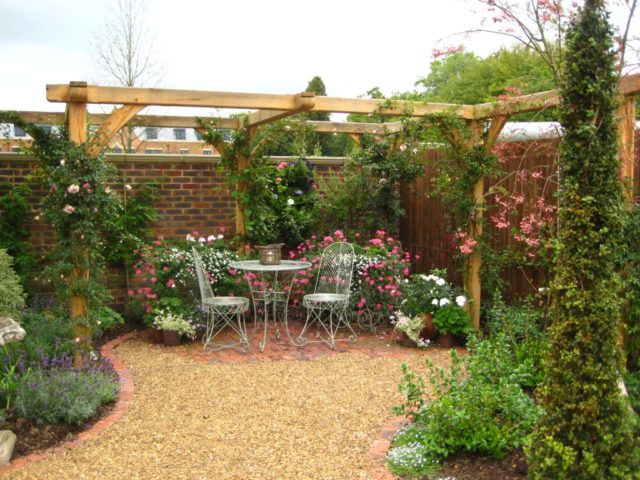
In the garden, decorative honeysuckle can be used for various purposes.
These plants retain their attractive appearance for a long time due to the rich green color and abundant flowering. After the fruits ripen, bright berries remain on the branches for a long time, and the foliage itself acquires a yellow or red color.
How to distinguish decorative from edible honeysuckle
Honeysuckle has over 200 different species, some of which are edible and not. The easiest way to distinguish them is by the shape of the berries. In edible varieties, they are dark blue or purple, with a bluish waxy bloom, elongated-oblong or spindle-shaped. Inedible ornamental honeysuckle forms round or oval red, orange or black berries. This perennial has one more feature. All edible varieties of this plant are bush, but inedible varieties can grow not only as a bush, but also as a liana.
Varieties of decorative honeysuckle with photos and names
All varieties of decorative honeysuckle can be roughly divided into 2 types:
- shrub;
- curly (vines).
Each of these groups includes quite a few different varieties, so a landscape designer always has a choice.
Shrub decorative honeysuckle
This group includes bush-shaped honeysuckle varieties. Dwarf forms of this type are used to decorate alpine hills, low curbs, larger plants are used to create hedges, they are planted as independent elements in group and single plantings.
Alpine
Alpine honeysuckle is a low (up to 1 m) rounded shrub with a spreading crown. The leaves are small, dense, bright green. Abundant flowering begins in May and lasts about 3 weeks. The flowers are yellow, devoid of aroma.
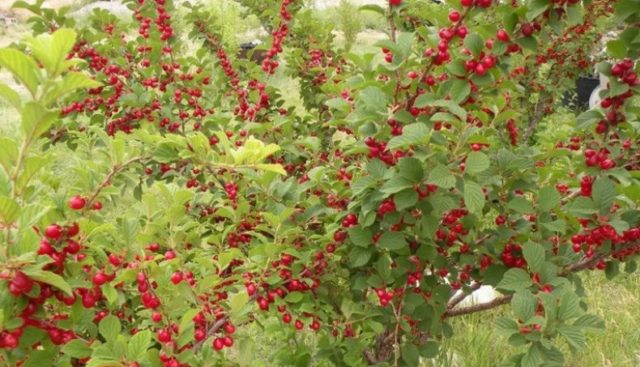
Abundant flowering gives way to no less intense fruiting
By September, the shrub is covered with cherry-sized dark red berries. Alpine honeysuckle is extremely unpretentious in cultivation and is resistant to diseases and pests.
Golden
Golden honeysuckle grows much higher, the bush of this plant can reach 4 m in height. It is spreading, consists of many strong shoots of light brown color. The leaves are large, dense, oval-elongated, with a pointed tip, can grow up to 12 cm in length.
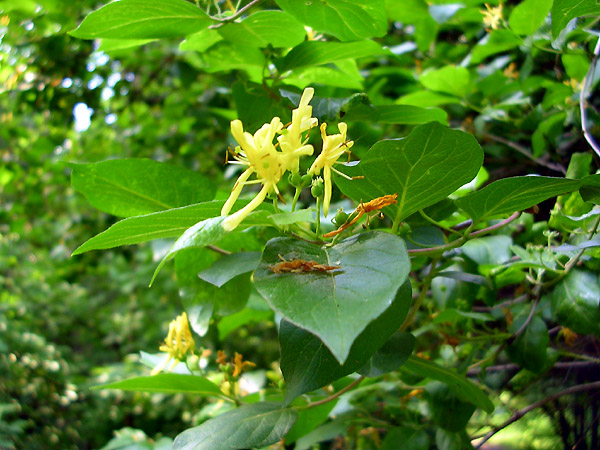
Golden honeysuckle flowers have a delicate pleasant aroma
At the end of May, many large yellow flowers with a delicate pleasant aroma appear on the shrub. Flowering lasts about 2 weeks. At the end of August, rounded red berries ripen in place of flowers.
Maaka
This type of decorative honeysuckle grows as a spreading bush up to 5 m tall. This shrub looks very impressive due to the dense foliage of the shoots. This gives the crown a significant density. Maak's honeysuckle is especially beautiful during flowering, when a large number of snow-white large flowers with an excellent aroma appear on it.
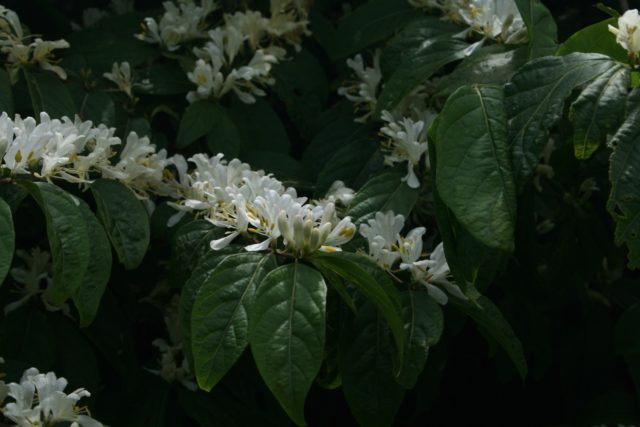
Maaka is more suitable for warmer regions
At the end of summer, a large number of purple-red berries ripen on the bush, which last for a long time and do not fall off even with the arrival of frost.
Maksimovich
Maksimovich's honeysuckle is considered one of the best shrubs for creating hedges. This species grows in dense, highly leafy bushes up to 2 m high.In early June, many purple-lilac flowers appear on them, and by autumn, bright red large ovoid berries ripen in their place, fused at the base and slightly resembling a heart.
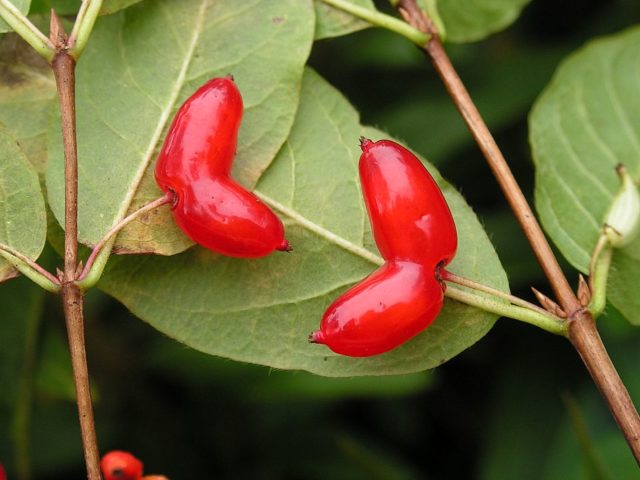
The fused fruits resemble a heart
Maksimovich's honeysuckle tolerates a haircut well, it is unpretentious, undemanding in care and is resistant to diseases and pests.
Bedspread
The bushes of this type of ornamental honeysuckle grow up to 3 m in height. The shoots of this shrub are densely covered with dark blue foliage, on which, during flowering, numerous bright yellow flowers with a lemon shade stand out brightly. They subsequently take on a rich purple color.
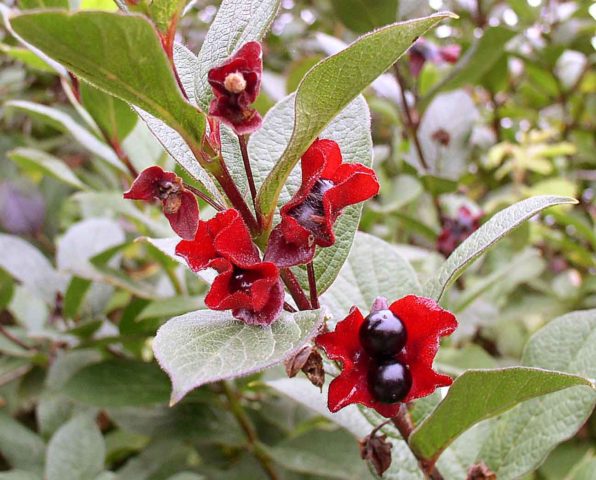
Shiny black berries on a background of red flowers look very impressive.
After flowering, black shiny berries ripen in pairs inside the bracts, giving the bushes a special decorative effect.
Tatarskaya
This is a type of bush ornamental honeysuckle, which includes varieties such as Large-flowered, Siberian, Alba and others. All of them are spreading shrubs with a lush crown, they can grow up to 4 m in height. They bloom in early summer with very beautiful white-pink paired flowers, in place of which red or orange berries appear at the end of summer.
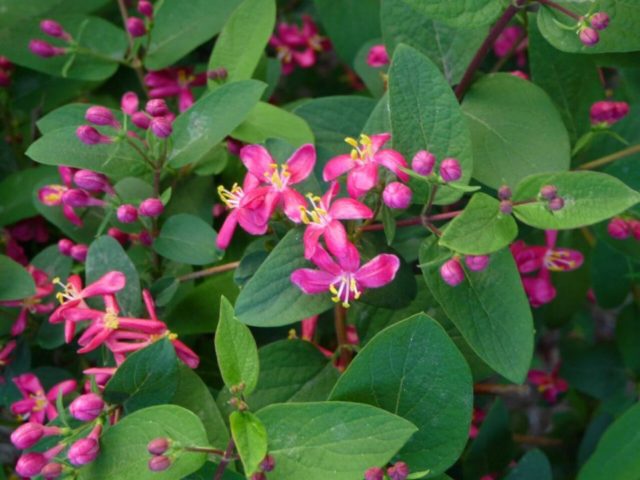
Two-colored flowers of the Tatar variety give the bush a special appeal.
Flowers of Tatar honeysuckle have a delicate pleasant aroma. The flowering period of this shrub can last about 3 weeks.
Curly decorative honeysuckle
A climbing variety of ornamental honeysuckle is used in landscape design as an intertwining plant for vertical gardening of various architectural objects. Here are several species of this perennial, often found in personal plots.
Honeysuckle
This plant forms thin red-brown vines, the length of which can be up to 6 m. Thanks to this, honeysuckle perfectly braids any support, arch or trellis. The single leaves of this plant have the ability to grow together, making the shoot look like it is passing through a leaf plate.

Honeysuckle is a common type of curly ornamental honeysuckle.
Honeysuckle flowers form at the tips of the shoots. They have different colors: red, white, pink, yellow, orange. Each flower lives for about 3 days, the full flowering cycle of this decorative honeysuckle takes about 3 weeks.
Brown
Brown's honeysuckle is one of the most beautiful climbing species of this plant. In length, its vines grow up to 3 m, which is less than that of honeysuckle. The leaves of the plant are dense, at the end of the shoot grow together in pairs. Brown's honeysuckle begins to bloom in the second half of June and lasts about 2 weeks.
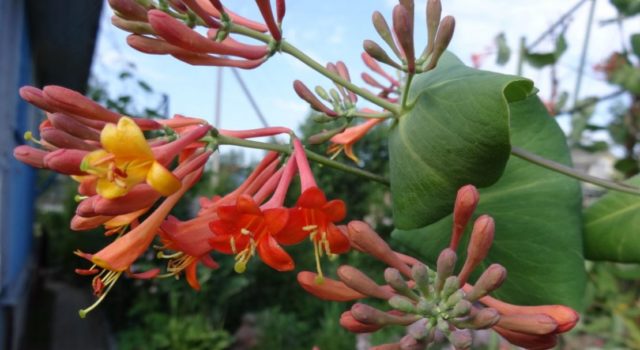
Long tubular corolla distinguishes Brown from other varieties
Bell-shaped flowers of red-orange color with a long tubular corolla are the hallmark of this shrub.
Henry
Henry's honeysuckle is a semi-evergreen climbing shrub. In good conditions, with a support, vines of this species can grow up to 8 m. The leaves are large, dense, oblong-ovate. Flowering begins in mid-summer.

Henry is raised with shelter for the winter
The flowers are medium-sized, yellow-red in color. The fruits are black shiny berries.
Hekrota
Honeysuckle Hecroth is a climbing shrub with vines up to 6 m. The leaves are large, opposite, elongated-pointed, bright green with a bluish tinge. This species blooms from June to September.
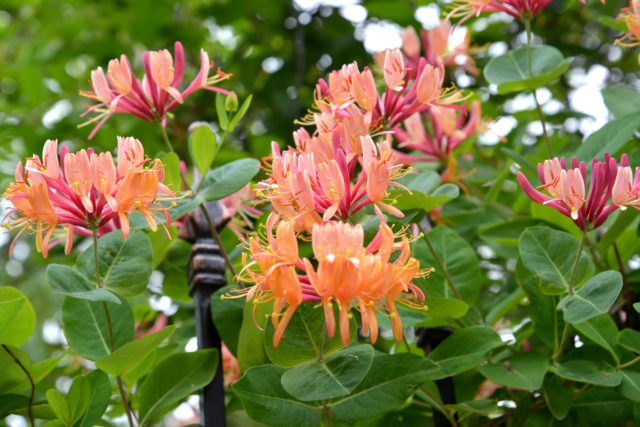
Large inflorescences of Hekroth are very effective
The flowers of this type of decorative honeysuckle are large, up to 4 cm, with a tubular corolla, outside it is red or purple, inside it is yellow-orange. Flowers grow in a group, cluster-like inflorescences of 20-30 pcs.
Telman
Thälmann's honeysuckle is an evergreen climbing shrub up to 6 m long, with oblong leaves, often growing together at the top of the shoots. Flowering of this species begins in June and lasts about 2 weeks.

Thälmann's honeysuckle is characterized by amicable and abundant flowering.
The flowers of this decorative honeysuckle are large, yellow-orange, collected in whorl inflorescences at the ends of the shoots. The flowering is friendly, very abundant.
Decorative honeysuckle in landscape design
In landscape design, decorative honeysuckle can be used for a variety of purposes. Its main purpose is curbs, hedges, mixborders. Shrub varieties are planted singly and in groups, combining them with each other, as well as with conifers.
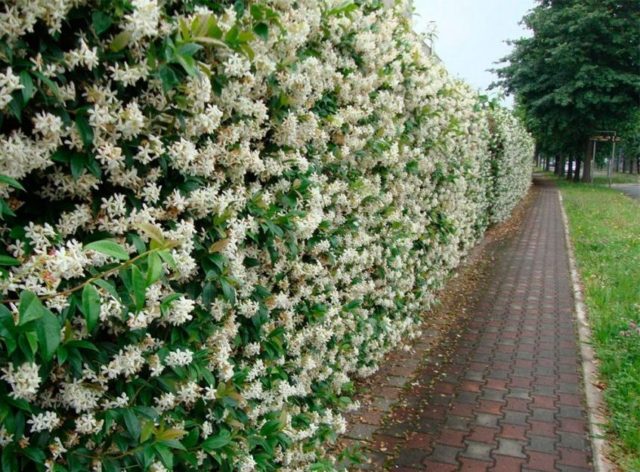
A solid wall of blooming honeysuckle will decorate any garden
Climbing species are used as intertwining plants to decorate vertical sections, walls, fences, various arched structures and other architectural elements of the garden.
Winter hardiness of decorative honeysuckle
Most types of ornamental honeysuckle have good frost resistance and can be grown without shelter for the winter. Shrub species are especially well adapted to frost. Curly decorative honeysuckle tolerates severe frosts worse, therefore, without shelter, it is grown only in the southern regions. In the northern regions, vines can freeze slightly, so for the winter they are removed from the support and covered.
Planting and caring for decorative honeysuckle
Ornamental honeysuckle is one of the most unpretentious garden plants. It grows well in almost all climatic zones, is undemanding to care, rarely gets sick. The agrotechnology of growing this shrub is not difficult, so both landscape design professionals and beginners love it.
Selection and preparation of the landing site
The planting site for ornamental honeysuckle is most often chosen for purely practical purposes, based on the direct purpose of these perennial shrubs. Therefore, the bushes are usually planted not where it will be better for them, but where the gardener or landscape designer needs it.Honeysuckle is quite calm about this, however, in order for the shrub to feel good, it is better to adhere to the following recommendations in choosing a place for planting it:
- The place should be well lit or partial shade, it is better if the site is protected from the north side.
- The soil is preferable to be loose and breathable, fertile, with a neutral level of acidity.
- The groundwater level is not higher than 1 m. Honeysuckle should not be planted in flooded areas or in those places where water stagnates after rains or melting snow.

The landing site must be dug up in advance
Before planting, it is better to dig up the site in advance, while adding rotted manure. If the soil is poor, then it is advisable to add a complex potassium-phosphorus fertilizer. Excessive acidity of the soil can be reduced by adding lime or dolomite flour.
Landing rules
The algorithm for planting an ornamental honeysuckle seedling is quite simple:
- A planting pit is prepared, in which an earthen lump from a container with a seedling must be guaranteed to be placed.
- The soil taken out of the pit is mixed with humus and peat, if the soil is clayey, you can add sand. Additionally, potassium-phosphorus fertilizer is applied, it is also advisable to add some wood ash.
- A drainage layer of small pebbles, pebbles or rubble is laid at the bottom of the planting pit.
- The seedling is removed from the container and placed in the center of the planting pit. In this case, the root collar of the plant should remain flush with the soil surface. If necessary, soil can be poured into the pit.
- The pit is gradually completely filled with soil with periodic compaction.

After planting, the root zone is mulched to retain moisture in the soil.
After planting is completed, the seedling is intensively watered, and its root zone is mulched with peat or humus.
Watering and feeding
Many varieties of ornamental honeysuckle are sensitive to a lack of moisture, so watering should be regular, especially in hot weather. At such a time, you need to water the bushes daily, pouring at least 10 liters of water under each plant. In cloudy weather, the frequency of watering should be reduced. Decorative honeysuckle is good for sprinkling, but this procedure should be carried out in the evening.
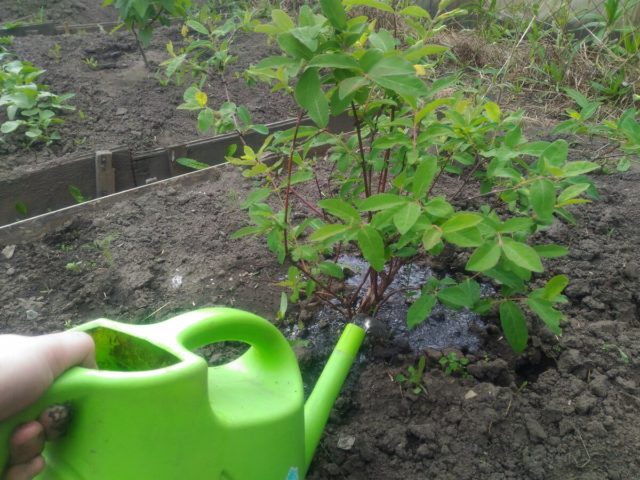
The plant loves regular watering
During the first 2-3 years after planting, the shrub is not fed. For this period, the plant has enough of those fertilizers that were applied during planting. Subsequently, decorative honeysuckle is fed every season according to the following scheme:
- Early spring - urea or nitroammophoska, granular fertilizer is scattered in the trunk circle. Nitrogen stimulates green mass growth and promotes shoot growth.
- Summer, the end of flowering - organic matter, humus or rotted manure is introduced into the root zone.
- Autumn, after fruit ripening - potash and phosphorus fertilizers to prepare for winter and lay flower buds.
How to form decorative honeysuckle
In the first years, bush decorative honeysuckle is practically not cut off, allowing the bush to grow and gain density. Only broken and dried branches are cut. Then the bushes are formed depending on their purpose, periodically cutting off the shoots that go beyond the size. Old bushes need rejuvenation from time to time, for this they remove part of the old shoots, replacing them with young ones.
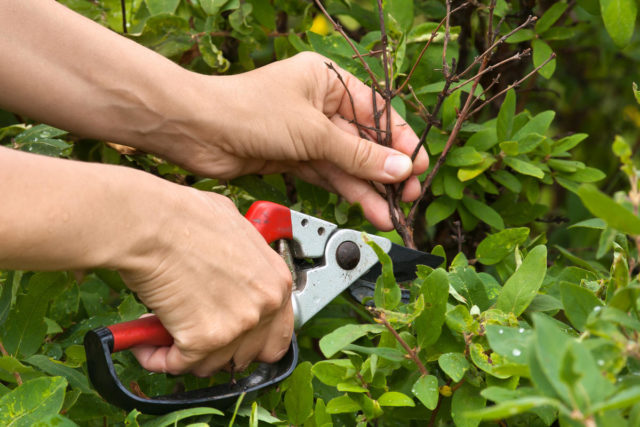
Dried shoots must be cut
Curly decorative honeysuckle is formed according to a similar pattern. For several years after planting the whip, the plants are not cut off, this continues until the vines reach the required length. Only damaged and dry shoots are removed. Subsequently, the vines are bred along the supports, cutting off excess lashes. Periodically, old shoots are cut out and replaced with younger ones.
Shelter of decorative honeysuckle for the winter
Adult bushes of decorative honeysuckle do not need shelter for the winter, but young seedlings may suffer, especially during the first winter. To preserve them, the bushes are covered with a layer of fallen leaves and spruce branches. Curly and creeping varieties, as a rule, tolerate frosts worse, so for the winter they are removed from their supports, laid on the ground or on a pillow of fallen leaves and covered with straw or spruce branches, and then additionally covered with snow. If the winter is mild, and there are no severe frosts in the region, then it is enough to insulate the root zone with a thick layer of mulch from peat or humus, additionally covering it with a layer of fallen leaves.
Reproduction
Decorative honeysuckle can be independently propagated both by seed and vegetative methods. Seeds are harvested in the fall from fully ripe berries, stratified by keeping them in the snow or in the refrigerator for several months, and planted in special mini-greenhouses in early spring.
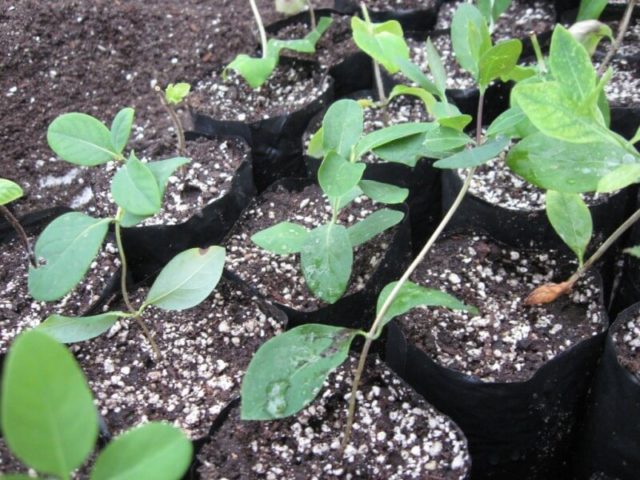
The plant can be propagated by seed, but it takes a long time.
Often, seeds are planted directly into the open ground, however, seedlings appear much later. Up to 2-3 years, the seedlings are grown in greenhouse conditions, and then the seedlings are transplanted to a permanent place in the open ground.
Of the vegetative propagation methods, cuttings are most often used. Decorative honeysuckle can be propagated by both lignified cuttings and annual, green ones. They are pre-rooted in water or in a nutrient substrate, and then planted in greenhouses for growing.
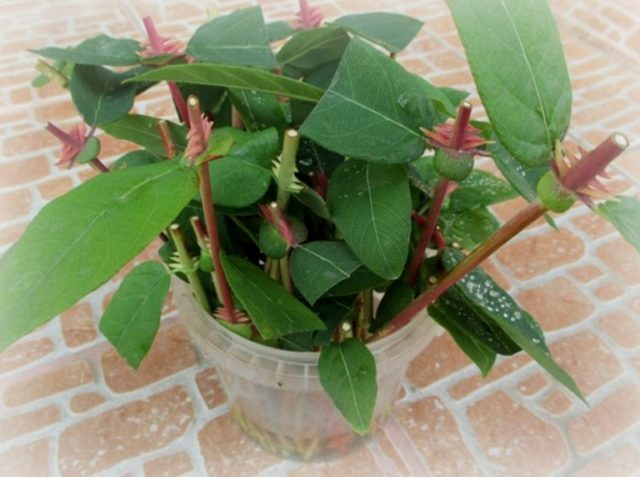
Cuttings root well in water
Mature overgrown bushes can be divided, this is also one of the methods of reproduction. In autumn or spring, the bush is completely dug out of the ground and divided into several parts so that in each section there are several shoots with its own root system. They should immediately be dropped off at a new location.
Diseases and pests
Honeysuckle has excellent immunity to diseases, so for a long time it was believed that it does not get sick at all. However, it is not. Due to various violations in the care of the bush, various fungal infections can develop, such as septoria, brown spot, powdery mildew. These diseases manifest themselves in the form of various spots on leaves and shoots, foci of rot.

Spots on honeysuckle leaves are a sign of a fungal disease.
For the prevention of fungal diseases, honeysuckle in early spring is treated with a solution of Bordeaux liquid. When foci of the disease appear during the season, the affected areas of the plant are cut out and burned, and the plantings are sprayed with fungicides.
Of the pests on decorative honeysuckle, aphids most often appear - a microscopic sucking insect. Small populations are not dangerous. However, due to the rapid reproduction, aphid colonies can very soon reach large sizes. The pest feeds on the sap of young leaves and shoots and poses a real threat in large quantities.

Aphids are a common garden pest
If insects are found on the leaves, the shrub can be treated with an ordinary solution of laundry soap, and then washed off with a stream of water. If the colony has reached a significant size, then it is better to use special drugs: Inta-Vir, Iskra, Decis, etc.
Conclusion
Ornamental honeysuckle is perhaps one of the most suitable plants for landscaping a personal plot. A variety of varieties, excellent appearance, combined with undemanding care, unpretentiousness and frost resistance, make this perennial shrub a real find for gardeners in many regions of Russia. Even in unfavorable climates, decorative honeysuckle grows well and does not lose its attractiveness for many years.








